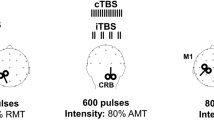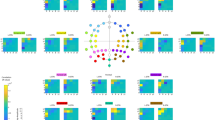Abstract
Beta oscillations (15–30 Hz) constitute an important electrophysiological signal recorded in the resting state over the human precentral gyrus. The brain circuitry involved in generating the beta oscillations is not well understood but appears to involve both cortical and subcortical structures. We have shown that single pulses of transcranial magnetic stimulation (TMS) applied over the primary motor cortex consistently elicit a brief beta oscillation. Reducing the local cortical excitability using low-frequency repetitive TMS does not change the amplitude of the induced beta oscillation (Van Der Werf and Paus in Exp Brain Res DOI 10.1007/s00221-006-0551-2). Here, we investigated the possible involvement of the thalamus in the cortically expressed beta response to single-pulse TMS. We included eight patients with Parkinson’s disease who had undergone unilateral surgical lesioning of the ventrolateral nucleus of the thalamus. We administered 50 single pulses of TMS, at an intensity of 120% of resting motor threshold, over the left and right primary motor cortex and, at the same time, recorded the electroencephalogram (EEG) using a 60-electrode cap. We were able to perform analyses on seven EEG data sets and found that stimulation of the unoperated hemisphere (with thalamus) resulted in higher amplitudes of the single-trial induced beta oscillations than in the operated hemisphere (with thalamotomy). The beta oscillation obtained in response to pulses applied over the unoperated hemisphere was also higher than that obtained in healthy controls. We suggest that (1) the beta oscillatory response to pulses of TMS applied over the primary motor cortex is higher in Parkinson’s disease patients, (2) thalamotomy serves to reduce the abnormally high TMS-induced beta oscillations, and (3) the motor thalamus facilitates the cortically generated oscillation, through cortico-subcortico-cortical feedback loops.





Similar content being viewed by others

References
Atkinson JD, Collins DL, Bertrand G, Peters TM, Pike GB, Sadikot AF (2002) Optimal location of thalamotomy lesions for tremor associated with Parkinson disease: a probabilistic analysis based on postoperative magnetic resonance imaging and an integrated digital atlas. J Neurosurg 96:854–866
Avoli M, Gloor P, Kostopoulos G, Naquet R (1990) Generalized epilepsy. Neurobiological approaches. Birkhaüser, Boston, USA
Bevan MD, Magill PJ, Terman D, Bolam JP, Wilson CJ (2002) Move to the rhythm: oscillations in the subthalamic nucleus-external globus pallidus network. Trends Neurosci 25:525–531
Brown P (2003) Oscillatory nature of human basal ganglia activity: relationship to the pathophysiology of Parkinson’s Disease. Mov Disord 18:357–363
Brown P, Williams D (2005) Basal ganglia local field potential activity: character and functional significance in the human. Clin Neurophysiol 116:2510–2519
Brown P, Oliviero A, Mazzone P, Insola A, Tonali P, Di Lazzaro V (2001) Dopamine dependency of oscillations between subthalamic nucleus and pallidum in Parkinson’s disease. J Neurosci 21:1033–1038
Cassidy M, Mazzone P, Oliviero A, Insola A, Tonali P, Di Lazzaro V, Brown P (2002) Movement-related changes in synchronization in the human basal ganglia. Brain 125:1235–1246
Colebatch JG, Dieber MP, Passingham RE, Friston KJ, Frackowiak RS (1991) Regional cerebral blood flow during voluntary arm and hand movements in human subjects. J Neurophysiol 65:1392–1401
Collins DL, Neelin P, Peters TM, Evans AC (1994) Automatic 3D intersubject registration of MR volumetric data in standardized Talairach space. J Comp Assist Tomogr 18:192–205
Deschênes M, Veinante P, Zhang ZW (1998) The organization of corticothalamic projections: reciprocity versus parity. Brain Res Rev 28:286–308
Dettmers C, Fink GR, Lemon RN, Stephan KM, Passingham RE, Silbersweig D, Holmes D, Ridding MC, Brooks DJ, Frakowiak RS (1995) Relation between cerebral activity and force in motor areas of the brain. J Neurophysiol 74:802–815
Doyle LMF, Kühn AA, Hariz M, Kupsch A, Schnieder G-H, Brown P (2005a) Levodopa-induced modulation of subthalamic beta oscillations during self-paced movements in patients with Parkinson’s disease. Eur J Neurosci 21:1403–1412
Doyle LMF, Yarrow K, Brown P (2005b) Lateralization of event-related beta desynchronization in the EEG during pre-cued reaction time tasks. Clin Neurophysiol 116:1879–1888
Duval C, Panisset M, Bertrand G, Sadikot AF (2000) Evidence that ventrolateral thalamotomy may eliminate the supraspinal component of both pathological and physiological tremors. Exp Brain Res 132:216–222
Foffani G, Bianchi AM, Baselli G, Priori A (2005) Movement-related frequency modulation of beta oscillatory activity in the human subthalamic nucleus. J Physiol 568:699–711
Fogelson N, Williams D, Tijssen M, Van Bruggen, Speelman H, Brown P (2006) Different functional loops between cerebral cortex and the subthalamic area in Parkinson’s disease. Cerebral Cortex 16:64–75
Grafton ST, Woods RP, Mazziota JC (1993) Within-arm somatotopy in human motor areas determined by positron emission tomography imaging of cerebral blood flow. Exp Brain Res 95:172–176
Hari R, Salmelin R (1997) Human cortical oscillations: a neuromagnetic view through the skull. Trends Neurosci 20:44–49
Ilinsky IA, Kultas-Ilinsky K, Rosina A, Haddy M (1987) Quantitative evaluation of crossed and uncrossed projections from basal ganglia and cerebellum to the cat thalamus. Neuroscience 21:207–227
Jahanshahi M, Jenkins IH, Brown RG, Marsden CD, Passingham RE, Brooks DJ (1995) Self-initiated versus externally triggered movements: I. An investigation using measurement of cerebral blood flow with PET and movement-related potentials in normal and Parkinson’s disease subjects. Brain 118:913–933
Jasper HH, Andrews HL (1936) Human brain rhythms I. Recording Techniques and preliminary results. J Gen Psychol 14:98–126
Jasper HH, Andrews HL (1938) Electroencephalography III. Normal differentiation of occipital and precentral regions in man. Arch Neurol Psychiat 39:96–115
Jasper HH, Penfield W (1949) Electrocorticograms in man: effect of voluntary movement upon the electrical activity of the precentral gyrus. Arch f Psych Zeitschr 183:163–174
Jenkins IH, Brooks DJ, Nixon PD, Frackowiak RS, Passingham RE (1994) Motor sequence learning: a study with positron emission tomography. J Neurosci 14:3775–3790
Kühn AA, Williams D, Kupsch A, Limousin P, Hariz M, Schneider G-H, Yarrow K, Brown P (2004) Event-related beta desynchronization in human subthalamic nucleus correlates with motor performance. Brain 127:735–746
Levy R, Ashby P, Hutchison WD, Lang AE, Lozano AM, Dostrovsky JO (2002) Dependence of subthalamic nucleus oscillations on movement and dopamine in Parkinson’s disease. Brain 125:1196–1209
Llinás RR, Ribary U, Jeanmonod D, Kronberg E, Mitra PP (1999) Thalamocortical dysrhythmia: a neurological and neuropsychiatric syndrome characterized by magnetoencephalography. Proc Natl Acad Sci USA 96:15222–15227
Lopes da Silva F (1991) Neural mechanisms underlying brain waves: from neural membranes to networks. Electroencephalogr Clin Neurophysiol 79:81–93
Matelli M, Rizzolatti G, Bettinardi V, Gilardi MC, Perani D, Rizzo G, Fazio F (1993) Activation of precentral and mesial motor areas during the execution of elementary proximal and distal arm movements: a PET study. NeuroReport 4:1295–1298
Marsden CD, Obeso JA (1994) The functions of the basal ganglia and the paradox of stereotaxic surgery in Parkinson’s disease. Brain 117:877–897
Marsden JF, Ashby P, Limousin-Dowsey P, Rothwell JC, Brown P (2000) Coherence between cerebellar thalamus, cortex and muscle in man. Cerebellar thalamus interactions. Brain 123:1459–1470
Marsden JF, Limousin-Dowsey P, Ashby P, Pollak P, Brown P (2001) Subthalamic nucleus, sensorimotor cortex and muscle interrelationships in Parkinson’s Disease. Brain 124:378–388
Neuper C, Pfurtscheller G (2001) Evidence for distinct beta resonance frequencies in human EEG related to specific sensorimotor cortical areas. Clin Neurophysiol 112:2084–2097
Niedermeyer E (1999) The normal EEG of the waking adult. In: Niedermeyer E, Lopes da Silva F (eds) Electroencephalography. Basic principles, clinical applications and related fields, 4th edn. Williams and Wilkins, Baltimore, pp 149–173
Ohye C (2000) Use of selective thalamotomy for various kinds of movement disorder, based on basic studies. Stereotact Funct Neurosurg 75:54–65
Paradiso G, Cunic D, Saint-Cyr JA, Hoque T, Lozano AM, Lang AE, Chen R (2004) Involvement of human thalamus in the preparation of self-paced movement. Brain 127:2717–2731
Paus T (2002) Combination of transcranial magnetic stimulation with brain imaging. In: Mazziotta J, Toga A (eds) Brain mapping: the methods, 2nd edn. Academic, San Diego, pp 691–705
Paus T (2003) Principles of functional neuroimaging. In: Schiffer RB, Rao SM, Fogel BS (eds) Neuropsychiatry, 2 edn. Lippincott, Williams and Wilkins, pp 63–90
Paus T, Petrides M, Evans AC, Meyer E (1993) Role of the human anterior cingulate cortex in the control of occulomotor, manual, and speech responses: a positron emission tomography study. J Neurophysiol 70:453–469
Paus T, Jech R, Thompson CJ, Comeau R, Peters T, Evans AC (1997) Transcranial magnetic stimulation during positron emission tomography: a new method of studying connectivity of the human cerebral cortex. J Neurosci 17:3178–3184
Paus T, Sipila PK, Strafella AP (2001) Synchronization of neuronal activity in the human sensorimotor cortex by transcranial magnetic stimulation: a combined TMS/EEG study. J Neurophysiol 86:1983–1990
Pfurtscheller G, Woertz M, Supp G, Lopes da Silva FH (2003) Early onset of post-movement beta electroencephalogram synchronization in the supplementary motor area during self-paced finger movement in man. Neurosci Lett 339:111–114
Pierantozzi M, Palmieria MG, Mazzone P, Marciania MG, Rossini PM, Stefani A, Giacomini P, Peppe A, Stanzione P (2002) Deep brain stimulation of both subthalamic nucleus and internal globus pallidus restores intracortical inhibition in Parkinson’s disease paralleling apomorphine effects: a paired magnetic stimulation study. Clin Neurophysiol 113:108–113
Priori A, Foffani G, Pesenti A, Bianchi A, Chiesa V, Baselli G, Caputo E, Tamma F, Rampini P, Egidi M, Locatelli Barbieri S, Scarlato G (2002) Neurol Sci 23:S101–S102
Priori A, Foffani G, Pesenti A, Tamma F, Bianchi AM, Pellegrini M, Locatelli M, Moxon KA, Villani RM (2004) Exp Neurol 189:369–379
Rouiller EM, Liang F, Babalian A, Moret V, Wiesendanger M (1994) Cerebellothalamocortical and pallidothalamocortical projections to the primary and supplementary motor cortical areas: a multiple tracing study in macaque monkeys. J Comp Neurol 345:185–213
Sarnthein J, Morel A, Von Stein A, Jeanmonod D (2003) Thalamic theta field potentials and EEG: high thalamocortical coherence in patients with neurogenic pain, epilepsy and movement disorders. Thalamus Related Syst 2:231–238
Schaltenbrand G, Wahren W (1977) Atlas of stereotaxy of the human brain. Thieme, Stuttgart
Schlaug G, Knorr U, Seitz R (1994) Inter-subject variability of cerebral activations in acquiring motor skill: a study with positron emission tomography. Exp Brain Res 98:523–534
Siebner HR, Rossmeier C, Mentschel C, Peinemann A, Conrad B (2000) Short-term motor improvement after sub-threshold 5-Hz repetitive tanscranial magnetic stimulation of the primary motor hand area in Parkinson’s disease. J Neurol Sci 178:91–94
Soikkeli R, Partanen J, Soininen H, Pääkkönen A, Riekkinen P Sr (1991) Slowing of EEG in Parkinson’s disease. Electroencephalogr Clin Neurophysiol 79:159–165
Steriade M (1999) Cellular substrates of brain rhythms. In: Niedermeyer E, Lopes da Silva F (eds) Electroencephalography. Basic principles, clinical applications and related fields, 4th edn. Williams and Wilkins, Baltimore, pp 28–75
St-Jean P, Sadikot AF, Collins L, Clonda D, Kasrai R, Evans AC, Peters TM (1998) Automated atlas integration and interactive three-dimensional visualization tools for planning and guidance in functional neurosurgery. IEEE Trans Med Imaging 17:672–680
Talairach J, Tournoux P (1988) Co-planar stereotactic atlas of the human brain: dimensional proportional system: an approach to cerebral imaging. Thieme, Stuttgart, Germany
Van Der Werf YD, Paus T (2006) The neural response to transcranial magnetic stimulation of the human motor cortex. I. Intracortical and cortico-cortical contributions. DOI 10.1007/s00221-006-0551-2
Virtanen J, Ruohonen J, Naatanen R, Ilmoniemi RJ (1999) Instrumentation for the measurement of electric brain responses to transcranial magnetic stimulation. Med Biol Eng Comput 37:332–326
Williams D, Tijssen M, Van Bruggen G, Bosch A, Insola A, Di Lazzaro V, Mazzone P, Oliviero A, Quartarone A, Speelman H, Brown P (2002). Dopamine-dependent changes in the functional connectivity between basal ganglia and cerebral cortex in humans. Brain 125:1558–1569
Author information
Authors and Affiliations
Corresponding author
Additional information
The first author was funded by a fellowship from the Canadian Institute of Health Research (CIHR).
Rights and permissions
About this article
Cite this article
Van Der Werf, Y.D., Sadikot, A.F., Strafella, A.P. et al. The neural response to transcranial magnetic stimulation of the human motor cortex. II. Thalamocortical contributions. Exp Brain Res 175, 246–255 (2006). https://doi.org/10.1007/s00221-006-0548-x
Received:
Accepted:
Published:
Issue Date:
DOI: https://doi.org/10.1007/s00221-006-0548-x



